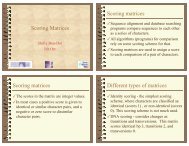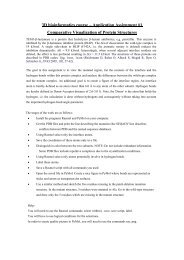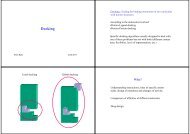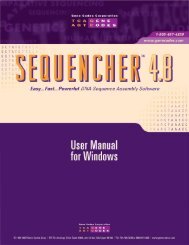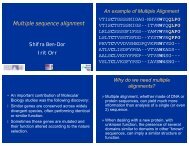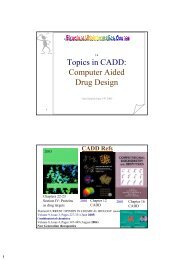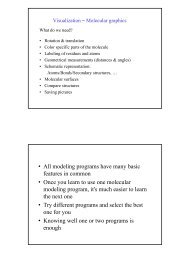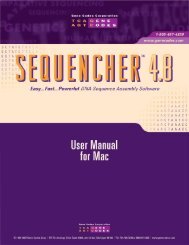Introduction to Phylogenetic Analysis
Introduction to Phylogenetic Analysis
Introduction to Phylogenetic Analysis
Create successful ePaper yourself
Turn your PDF publications into a flip-book with our unique Google optimized e-Paper software.
Character Based Methods - Maximum<br />
Parsimony<br />
∞ The Maximum Parsimony method is good for<br />
similar sequences, a sequences group with<br />
small amount of variations<br />
Maximum Parsimony methods do not give the<br />
branch lengths only the branch order.<br />
For larger set it is recommended <strong>to</strong> use<br />
the “branch and bound” method instead<br />
Of Maximum Parsimony.<br />
Character Based Methods -<br />
Maximum Likelihood<br />
Basic idea of Maximum Likelihood method is<br />
building a tree based on mathemaical model.<br />
This method find a tree based on probability<br />
calculations that best accounts for the large<br />
amount of variations of the data (sequences)<br />
set.<br />
Maximum Likelihood method (like the Maximum<br />
Parsimony method) performs its analysis on<br />
each position of the multiple alignment.<br />
This is why this method is very heavy on CPU.<br />
Maximum Parsimony Methods are<br />
Available…<br />
For DNA in Programs:<br />
paup, molphy,phylo_win<br />
In the Phylip package:<br />
DNAPars, DNAPenny, etc..<br />
For Protein in Programs:<br />
paup, molphy,phylo_win<br />
In the Phylip package:<br />
PROTPars<br />
Character Based Methods -<br />
Maximum Likelihood<br />
Maximum Likelihood method – using a tree<br />
model for nucleotide substitutions, it will try <strong>to</strong><br />
find the most likely tree (out of all the trees of<br />
the given dataset).<br />
The Maximum Likelihood methods are very slow<br />
and cpu consuming.<br />
Maximum Likelihood methods can be found in<br />
phylip, paup or puzzle.



